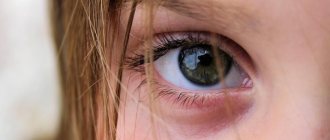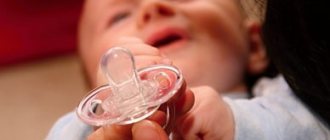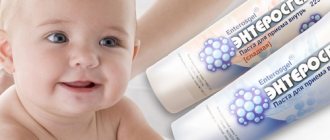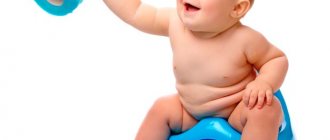Anemia in a baby under one year old
Most likely, even during pregnancy you came across such a medical term as anemia, but even in a nightmare you could not imagine that this diagnosis could be applied to your baby. Unfortunately, in recent years, childhood anemia has begun to occur more and more often.
We all know that anemia or anemia is a low level of hemoglobin in the blood. From the moment of birth and throughout the first year of life, a child’s normal hemoglobin levels are 145 grams per liter of blood.
There are 3 degrees of anemia, which is diagnosed in children under one year of age. The most common type of anemia is iron deficiency or hypochromic. The cause of the disease is iron deficiency in the body.
Another type is hemolytic, the cause may be Rh conflict, an infectious disease of the mother during pregnancy. The last type of disease is nutritional, which occurs due to poor nutrition.
Anemia has three degrees of severity, which differ in the level of lack of hemoglobin in the blood.
- When the level is below normal but above 90
- Hemoglobin level from 90 to 70
- The most severe stage 3 is when the hemoglobin level drops below 70
Diagnosis and norm of hemoglobin in a child
To diagnose hemoglobin levels, you need to take a general blood test
For the study, a general blood test is prescribed and all indicators are assessed. Blood is donated on an empty stomach. The last meal should be no later than 8 hours before blood sampling.
The hemoglobin level is determined in several ways, taking into account the instruments available in the laboratory. The Sali method is usually used to measure hemoglobin levels in the blood. This method involves mixing blood with hydrochloric acid and then adding distilled water to obtain a standard color. This method is longer and more subjective, and has been used for a very long time. You can also determine your hemoglobin level using automated methods, using a hemometer. In blood test results, hemoglobin is designated Hg.
The normal hemoglobin value varies depending on the child’s age:
- Normally, in infants up to 1 month, the hemoglobin level is 115-180 g/l.
- In children under six months of age, the concentration is within the normal range of 90-140 g/l.
- From 6 months to a year – 105-140 g/l.
- The hemoglobin level in children under 5 years of age is 100-140 g/l,
- From 5 to 12 years – 115-145 g/l.
In adolescence, girls and boys have different indicators:
- For girls 12-15 years old, the lower limit is 112 g/l, and the upper limit is 152 g/l.
- For young men, the norm is in the range of 120-160 g/l.
Causes
What can affect the development of the disease in an infant?
When a baby is born, its body has a reserve of iron, which is enough for the baby for the first six months of life. Next, iron should come from food.
Before birth
- Folic acid deficiency
- Mother's bleeding
- Maternal iron deficiency
- Poor nutrition of a woman
- Abnormal development of the umbilical cord
- Abnormal development of the placenta
- Birth injury
- Premature pregnancy
- Untied umbilical cord
After birth
- Artificial feeding
- Feeding your baby whole milk
- Infectious diseases, bleeding
- Intestinal pathologies
- Hereditary diseases
- Rapid development of muscle mass
- Rapid bone development
- Lead poisoning
- Chronic inflammation
Treatment
To increase hemoglobin in an infant, an integrated approach is important. Having established the cause of this situation, the doctor will prescribe medications and also recommend how to change the diet of the baby or his mother.
It is also important to take frequent walks with the baby and limit the child from stress.
Nutrition for anemia in adolescents should be high in calories, low in fat (up to 30 grams per day) and a large amount of animal protein in the daily diet. For better absorption of the microelement, it is recommended to separate the intake of foods with iron and calcium.
The main role in the treatment of iron deficiency anemia is played by iron supplements for adolescents, since it is impossible to increase hemoglobin in a teenager only by correcting nutrition; the iron content in foods is several times lower than the therapeutic dose. More often, medications are prescribed in tablet form - they are more convenient to take at home, and they are also easier to tolerate; injections are less common.
How to increase hemoglobin in a teenager using iron supplements (basic rules of treatment):
- There should be approximately the same period of time between tablets;
- during use, you should strictly adhere to the dosage prescribed by your doctor;
- It is best to take the tablets half an hour before meals; if side effects are severe, they can be taken with meals;
- For better absorption of iron, it is recommended to take additional vitamin C if it is not contained in the preparation.
To prevent anemia, it is recommended to eat a balanced diet, regularly eat meat, spend more time in the fresh air, reduce physical activity to moderate, and take vitamins with iron for teenagers.
If there is a lack of iron in the body, Actiferrin is prescribed.
When the question arises of how to increase a child’s hemoglobin, you should not self-medicate. At home, you are unable to make a correct diagnosis and, therefore, begin adequate therapy.
- If blood loss is to blame, then a transfusion is necessary.
- If the reason is mechanical destruction of red blood cells, then an exchange transfusion will be required. At the same time, the baby’s blood is gradually replaced with donor blood.
- If the toddler is fed breast milk, then it is necessary for the mother to adjust her diet to include foods rich in iron.
- If the baby is already consuming complementary foods, then it is necessary to enrich his diet with iron-containing foods.
- If the cause is iron deficiency, it is necessary to use drugs with a high iron content, for example, Actiferrin or Ferronal 35.
- Frequent walks outside are important; oxygen affects the formation of red blood cells.
Nutritional Features
In addition, it is important that the baby’s diet includes foods high in iron; a varied menu is very important.
- beef;
- liver;
- turkey, rabbit, chicken meat;
- beef tongue, heart;
- fish, in particular mackerel;
- egg yolk;
- black caviar.
Particular attention should be paid to products of plant origin. The baby's diet should include:
- legumes, namely lentils, peas, beans;
- seaweed;
- oatmeal, buckwheat porridge;
- berries, in particular strawberries, black currants, cranberries, blueberries, raspberries, gooseberries;
- fruits, namely bananas, apples, persimmons, pears, peaches, pomegranates;
- vegetables, in particular cauliflower and greens, carrots.
Vegetables can be given raw, boiled or baked. You can make jelly, jelly, fruit juice or compote from fruits and berries.
It is recommended to exclude or at least limit the consumption of tea, soy, and coffee.
Traditional methods
- Infusion of honey, lemon with rose hips. The berries (a tablespoon) are poured with boiling water (a glass) and left to steep for three hours, preferably in a thermos. After this, filter, add a slice of lemon and a teaspoon of honey. The finished product is divided into two parts and given to drink in the morning and evening.
- Juice mixture. To do this, you will need to squeeze juice from beets, carrots, apples (1:1:2). Take a glass a day. Before eating it, it is recommended to eat a spoonful of sour cream.
- A sweet mass of dried apricots, raisins, prunes, lemon, walnuts (100 grams each) and a glass of honey. The ingredients are pre-ground in a meat grinder and mixed with honey. The child receives a teaspoon twice a day.
- A mixture of nuts and buckwheat. For this remedy you will need buckwheat (dry), honey, nuts (in equal proportions). Nuts and buckwheat are ground in a coffee grinder until crushed crumbs are obtained, then mixed with honey. The finished product is given to the baby a teaspoon twice a day.
Symptoms
How to understand whether your child has a problem even before taking tests. To do this, a list of external symptoms will help.
- Weakness
- Baby doesn't sleep well
- Baby's skin is dry and pale
- Possible cracks in the corners of the mouth
- Hair grows poorly, nails are brittle
- Poor appetite
- Baby spits up often
- Weight gain is too small
- Problems with the gastrointestinal tract
- Retarded physical, mental and motor development
If a mother notices one or more of the listed symptoms in her child, then she must report her suspicions to the doctor.
How to increase hemoglobin using folk remedies?
The following proven recipes will help normalize hemoglobin levels:
- For 4-8 weeks, regularly drink 30 g of fresh beet juice or 150 g of boiled beets.
- Pour 2 tablespoons of rose hips with a glass of boiling water and leave to infuse in a thermos overnight. Drink the resulting decoction 0.5-1 glass per day. In addition to the therapeutic effect, such a drink will invigorate you no worse than a cup of strong coffee.
- Take a tablespoon of rowan berry juice up to 4 times a day.
- Carrot salad with sour cream is a tasty and healthy way to raise hemoglobin, which even children will like. It is also recommended to drink fresh carrot juice: 100-150 ml three times a day.
- Pour boiling water over a tablespoon of nettle and leave for 30 minutes. Take the decoction 3-4 times a day. You can add fresh nettle leaves to vegetable salads after dousing them with boiling water.
- Nuts are a good source of iron. It is recommended to eat at least 100 g of walnuts per day, mixing them with natural honey before use.
- Absolutely everyone needs to eat apples every day. To increase hemoglobin, you should consume at least 0.5 kg of apples daily.
- Sprouted wheat helps increase hemoglobin. Initially, it is recommended to consume 1 teaspoon before breakfast, gradually increasing the dose to two tablespoons.
- Vitamin mixture: take walnuts, raisins, dried apricots, honey in equal quantities. Grind all ingredients in a meat grinder or blender, mix with honey. Use the mixture every morning and store it on the bottom shelf of the refrigerator.
Nutrition for anemia
How is anemia treated?
First of all, iron-containing drugs are prescribed. A special therapeutic diet is also required. By the way: Milk affects iron absorption, so it is advisable to give medications between feedings.
What can we say regarding nutrition, since iron deficiency anemia is most common in children, therefore, the mother should focus on foods that contain large amounts of iron.
If we talk about a baby who is breastfed, then the mother must also monitor her diet. A nursing woman should definitely eat beef, veal, and fish.
Vegetables must be present: potatoes, carrots, beets, cabbage. From fruits, apples, pomegranate, currants, banana, kiwi, lemon. Also be sure to take a course of vitamins.
What is hemoglobin?
Hemoglobin, as mentioned above, is an iron-containing peptide compound that transports oxides in the human body. This protein gives the characteristic color of blood due to the presence of “heme” in its composition. Depending on the type of iron-containing protein, the color of the blood also differs.
Hemoglobin has three forms:
- Oxyhemoglobin;
- Carboxyhemoglobin;
- Deoxyhemoglobin.
Oxyhemoglobin transports oxygen to necessary areas of the body. It gives arterial blood a bright scarlet color. The second type of iron-containing protein (carboxyhemoglobin) helps eliminate carbon dioxide and other carbon oxides. Deoxyhemoglobin is reduced hemoglobin that circulates in free form in the bloodstream.
Iron peptide
In newborns, hemoglobin begins to be synthesized by the bone marrow in the early stages of development. It is very different from the iron protein found in the adult body. Such hemoglobin is usually called “fetal”. During ontogenesis, this peptide compound is replaced by ordinary hemoglobin. Therefore, a one-year-old child already has “adult” iron-containing protein.
At the initial stages of ontogenesis, the norm of hemoglobin in the child’s bloodstream is variable. This indicator needs constant monitoring, because deviations can lead to serious consequences.
When to introduce complementary foods
For children with anemia, it is allowed to introduce complementary foods one month earlier than the due date, this means that a baby can try the first adult food from 5 months, and an artificial one from 4.5 months.
The first thing that should appear in a child’s diet is vegetables. But which vegetables to choose? The ideal option would be cauliflower or broccoli. Next are zucchini, potatoes, carrots, pumpkin. The principles of administration are the same as for healthy children.
We give a spoonful of complementary foods, monitor the reaction, everything is fine, we continue to introduce. A minimum of 7 days is allocated for the introduction of each new product.
By 6 months, porridge is introduced; buckwheat porridge is perfect for the first complementary feeding. And so all the products that are allowed for a child of this age are gradually introduced.
Natural remedies to increase Hb
In addition to nutrition, traditional medicine will help with low hemoglobin. At home, you can prepare delicious, healthy remedies based on simple ingredients to quickly normalize your blood composition and improve your well-being.
Recipes:
- Grind the beets in a medium-sized meat grinder and squeeze the juice through cheesecloth. Leave it to sit in the open air. Dilute with cool boiled water in a ratio of 1 to 2. Drink 50 ml 2-3 times a month during the day.
- The same method, but instead of water, you need to take 4 parts of apple juice. The vitamin C contained in it will improve the absorption of iron into the blood, so the remedy will act faster.
- Wash the fresh dandelion root and grate it. 1 tbsp. l. pour 150 ml of boiling water, cover with a lid, leave for 3 hours. Strain and store in the refrigerator. Take the resulting decoction 1 tbsp. l. in the morning and before bed.
- Grind 3 tbsp. l. rose hips, place in a thermos, pour 500 ml of boiling water. Leave for 4-6 hours (preferably overnight). After cooking, drain the broth, add 2 tbsp. l. natural honey, divided into two doses. Drink warm.
- You can prepare a vitamin mixture that increases hemoglobin, immunity, improves brain and heart function from dried fruits, honey and nuts. You will need 100 g of dried apricots, raisins, figs, hazelnuts. Grind all ingredients in a meat grinder to obtain a homogeneous mass. Add 250 ml of liquid honey, juice of one lemon with pulp. Mix and store in a glass, sealable container in the cold. Every morning before breakfast, eat 1 tbsp. l mixture (children 1 tsp).
- 1 tbsp. l. Pour a glass of hot water over nettle leaves and buckwheat inflorescences and leave for 2 hours. Drink 50 ml 3-4 times a day.
- Sort out the green (not roasted) buckwheat and grind in a coffee grinder until it becomes a homogeneous powder. Add 1 tbsp. l. in food or eat with water or juice every day.
- A cleansing salad helps remove slagging from the intestines, which improves iron absorption and saturates the body with vitamins and microelements necessary to increase hemoglobin levels. Grate or cut into thin strips one carrot and one beet at a time, add a little vegetable oil to taste, squeeze out a few drops of lemon juice. Eat for breakfast or dinner.










